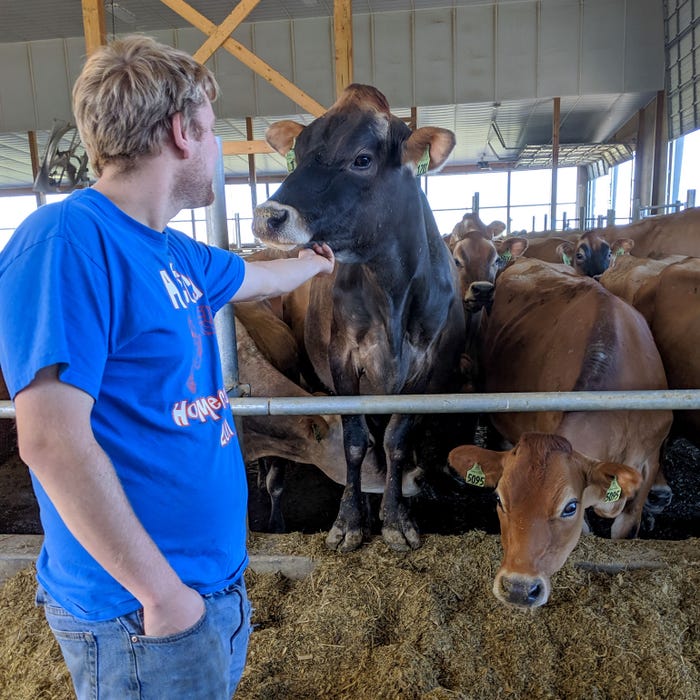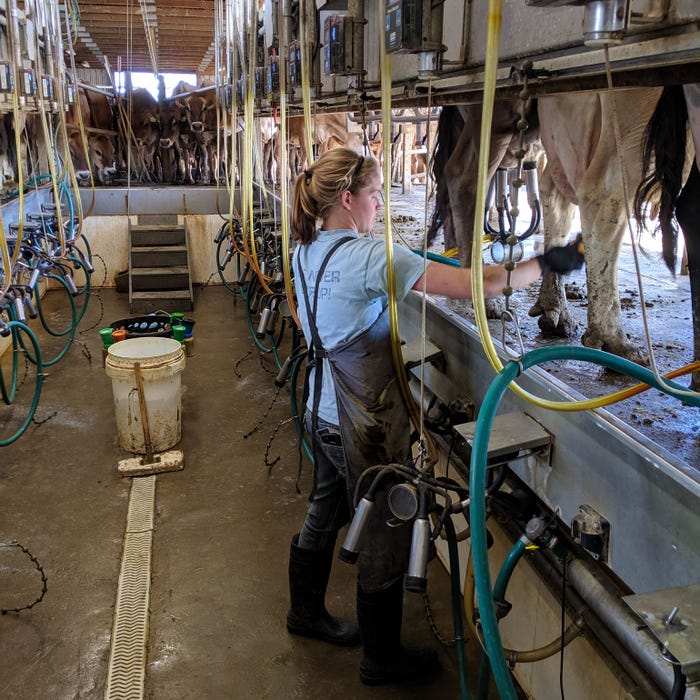When someone walks into his free-stall barn, Lyman Rudgers wants them to get thirsty for a glass of milk.
"I want somebody to be able to come in here and think, ‘This is where I want my milk produced,’" he says.
Efficiency and cow comfort are what drives he and his wife, Chelsey, in their day-to-day decision-making at their Attica, N.Y., dairy, Rudgers Registered Jerseys.
The couple co-own the business with Chelsey’s parents. Their journey into dairy farming started in the summer of 2013. Lyman worked at the time for Boxler Dairy Farm in Varysburg, N.Y., where he managed the calf and heifer program. He and Chelsey talked to her parents about raising cows on the farm — her parents at the time raised beef steers and custom-boarded heifers for another dairy.
So her parents took the steers out of an old tie-stall barn, gutted it and put new stalls in, installed a pipeline and small tanks, and started milking 23 head.
“It’s kind of been a whirlwind from there,” Lyman says.
When a farming couple they knew wanted someone to lease their cows, the couple jumped at the opportunity and took on another 30 head. By the spring 2014, the couple cut back on boarded heifers, put in sand-bedded free stalls and turned the tie stalls into a flat barn parlor.
The free stall held 180 cows, so they leased another herd of cows bringing the milking numbers to 120 head, plus dry cows and pregnant heifers.
On July 4, 2015, the couple broke ground on a new parlor and calving pack addition. They built a double-10 parallel parlor with rapid exit. The retrofitted tie stalls were used for youngstock.
“Basically we went from 23 to 180 in about three years," he says.
What drove the expansion of the dairy was the custom heifer-raising business dwindling. They had the stalls and space, and the milk market for more cows. They even hired someone to raise their own heifers for them since they didn’t have space.
In August 2018, they broke ground on a new free-stall barn, and in December of that year brought all the heifers home.
“We really pride ourselves on being as efficient as we can be with the cows and the land,” he says.
Partners in business
The farm is a partnership between the couple and Chelsey’s parents, who own the buildings and the land. Lyman and Chelsey own the animals and run the business, while Chelsey’s father does heifer barn cleaning and hauls manure.
"It works out really well," Lyman says, adding that they’re in the process of buying the farm equipment and plan on purchasing the land in the next few years.
The couple are building equity from their cattle. They leased so many cows at first that their equity wasn't high, but now they own more of their own cattle and their equity has grown a little each year. Within five to seven years, he says, they should be able to buy the land.
 RAPID EXPANSION: “Basically we went from 23 (head) to 180 in about three years,” is how Lyman describes the couple’s rapid expansion of their farm.
RAPID EXPANSION: “Basically we went from 23 (head) to 180 in about three years,” is how Lyman describes the couple’s rapid expansion of their farm.

Chelsey’s parents own 150 acres, but the total acreage farmed is 500 acres.
One of the biggest things the couple pushes is cow comfort. In the milk barn, they emphasize stall sizes, deep sand beds and fans for cow comfort.
And the key to making the partnership work? “Communication is kind of the big one,” Lyman says. “Everybody knows what they’re supposed to do, what they’re jobs are. There is no micro-managing here.”
Dealing with dumping
Like many other dairy farmers in the Northeast, the couple have had to dump milk this spring.
They started dumping milk on May 15 after being told by their small cooperative — Wesco, a 19-member milk cooperative whose milk goes to a Sorrento Lactalis plant for cheese production — that they had to cut production by 10% off March base production. That was until May 31. From June 1-30, they had to cut production by 5%. After July 1, they’ll be able to get back to full production.
“So it's not super long lived, but it's still a challenging situation," he says.
They had several cows with poor udders and not a great track record of reproduction. Lyman says they culled heavily there, selling every single one as a share of beef.
“We did much better that way,” he says. “We were able to gross about $1,200 a cow, which is about five times what we would make at the auction barn.”
They also switched from feeding calves milk replacer to whole milk and started raising bull calves to an older age, keeping them for several weeks instead of just one week. They also increased the weaning age on their heifer calves, from 8 weeks to 10 weeks.
“I don’t want to cut back so much that we’re not shipping as much as we can. I’d rather dump a little bit just to have a little bit of margin per error if you will,” Lyman says.
Robotic future?
Unlike other dairy farms, finding dependable labor hasn’t been an issue for the farm. They have one full-time worker and four part-time workers, mostly area high school students.
But they’re getting ready for an automated future, even if that’s several years down the road. Lyman says the new barn has an insulated ceiling that is already set up for robots. It has an automated manure scraper and a feed pusher.
He says they could plug in two to four robots in the existing barn with no problem.
Hindsight is always 20-20, and there are things Lyman says that he would have done differently to get the business started. Leasing cows, he says, was the right move from a cashflow standpoint, but it prevented them from building equity in the business.
He also wishes he would’ve hired someone who was good at growing crops, especially hay.
 DEALING WITH COVID: The effects of the COVID-19 pandemic on dairy markets forced the Rudgers to cut milk production by 10% in May. They’ll be allowed to go back to full production on July 1, but the drop in production has cut into profitability.
DEALING WITH COVID: The effects of the COVID-19 pandemic on dairy markets forced the Rudgers to cut milk production by 10% in May. They’ll be allowed to go back to full production on July 1, but the drop in production has cut into profitability.

For young people getting into dairy farming, Lyman has some advice.
“You've got to be willing to work an obscene amount of hours, at least for the first five or 10 years," he says. “If we didn't have our family and some of my good friends and Chelsey's good friends, we wouldn't have survived.”
The most important piece of advice, though? Start by buying a few cows, have someone milk them for you and build your own equity.
“Because you got to have a little pot of something that when you go to the bank and say, ‘Hey, I need X amount of dollars to get started,’ you’ve got something to show for what you’ve worked for thus far,” he says. “If you can work the hours and take good care of the cows, good quality feed and make sure they are comfortable, they will pay you back every time.”
About the Author(s)
You May Also Like






